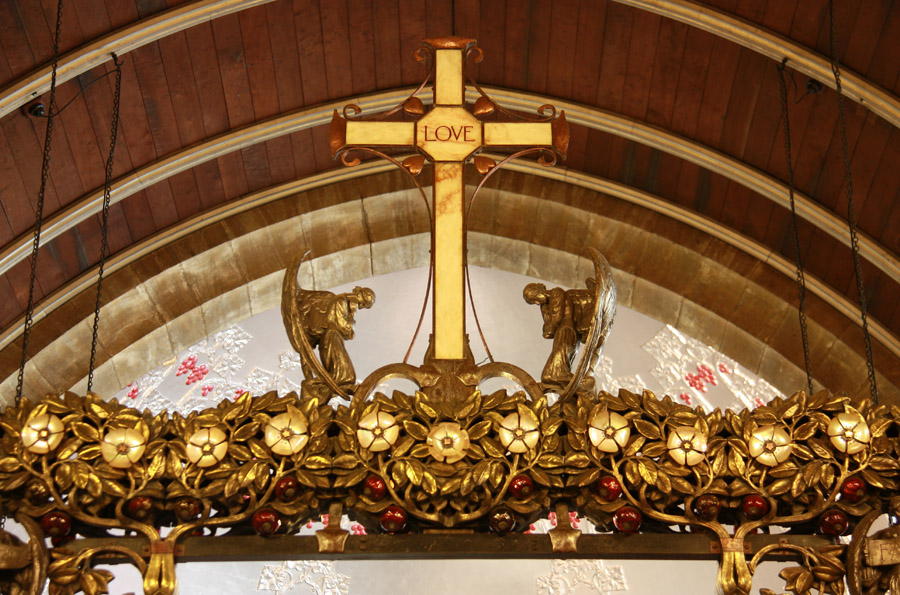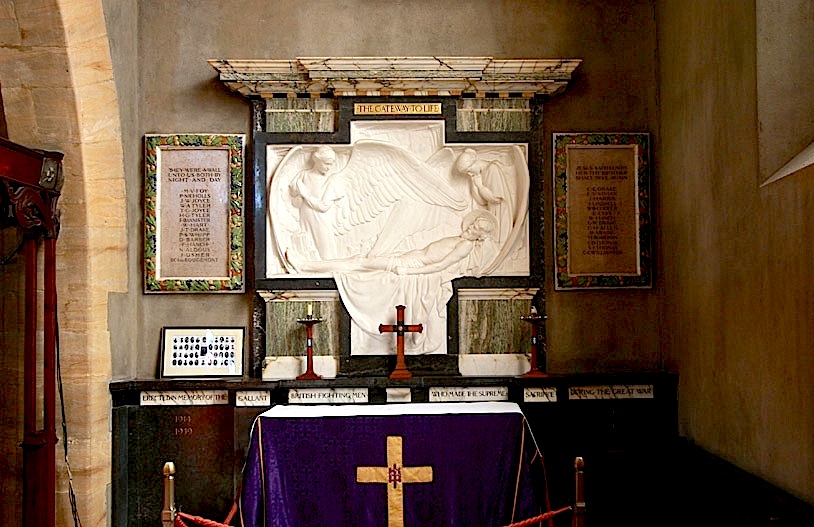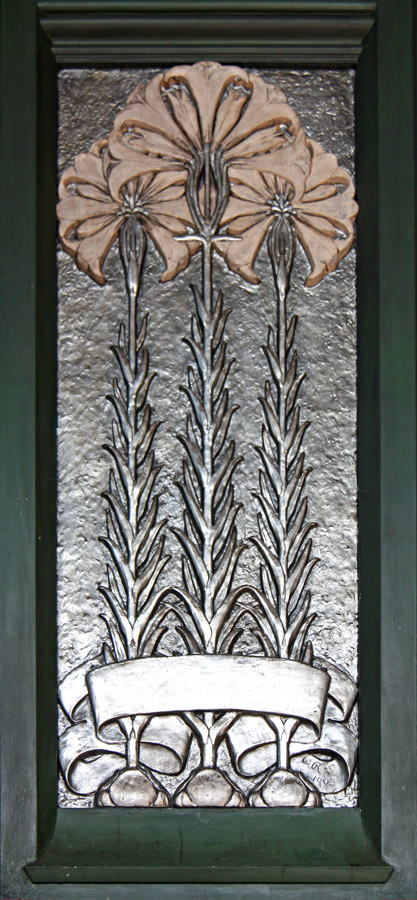Photographs by John Salmon. You may use these images without prior permission for any scholarly or educational purpose as long as you (1) credit John Salmon and (2) link your document to this URL in a web document or cite the Victorian Web in a print one. Click on the images to enlarge them.
The Reredos

William Reynolds-Stephens (1862-1943) had already proved himself a brilliant all-rounder before he was commissioned early in the twentieth century for the interior of St Mary the Virgin, Great Warley, Essex. Now, with a generous benefactor (see Part I) and in collaboration with the architect of the church, Charles Harrison Townsend, he had a chance to roll out "as complete a programme of early twentieth-century design as Charles Rennie Mackintosh or Otto Wagner [in Vienna]" (Jenkins 218). The single most important fitting — its focal point — was the reredos. Commentators agree that this, with its central figure of the risen Christ in an opulent setting, is the very climax of the whole interior.

The figure, hand raised in blessing, is fashioned of "oxidised silver on copper" (Bettley and Pevsner 430), with a motif of vines and grapes in the background panel and mother-of-pearl inlays on both. On the surrounding arch are four small reliefs with emblems of the four evangelists, such as the lion for St Mark on the lower righthand side, while on either side of the archway are larger reliefs depicting the beginning and end of Jesus's earthly life. Below these are are mother-of-pearl roses on brass rose-trees, set on marble. Behind the reredos gleams the aluminium that covers the apse; further up, the embossed vines that spring from behind the reredos bear red-painted grapes to symbolise the Communion. The use of various materials here (and this is not a complete description) make this a tour de force of design and craftsmanship. Notice how the design of the two wooden candleholders in the top picture picks up the motif of twining poppy leaf heads from the south chapel screen.
The Organ


The organ case is similarly elaborate, combining hammered steel with copper reliefs, this time of texts and scenes from the Benedicte, such as (in the one just glimpsed on the lower right) "Praise Him and Magnify Him Forever, O All that Move in the Waters" with a lovely scene of fish and undulating underwater life. The surround is decorated with ruby-coloured glass and mother-of-pearl, and an angel looks out from the very peak of the canopy, for all the world like a little figurehead. Townsend's rich walnut but unfussy choir-stalls set off the instrument beautifully.
Details of the Chancel Screen


This again is a work of art. "The slender-stemmed trees of which it is composed rise from the marble base," explains A. L. Baldry, "and their crowns of foliage interlacing above make a rich mass of admirably treated detail. On each tree is placed a symbolical winged figure, and above, in the centre, is a cross flanked by two angels typifying "Gentleness" and "Goodness." Baldry finds this perhaps "the best display of the wonderful ingenuity in design, which is one of the most distinguished characteristics ot the whole of the work that Mr. Reynolds-Stephens has accomplished during his career" (15). The word "Love" is inscribed on the cross, and four tiny ruby-coloured hearts surround it — the hearts are another motif found throughout the church. Looking at the bigger picture, Alan Crawford writes helpfully that the screen "has the shape and function of a Gothic screen, but it has been naturalised in the spirit of the Arts and Crafts" (73).
South Chapel Reredos

This reredos, The Gateway to Life with its marble relief of the crucified Christ in the sepulchre before the Resurrection, came later, when the chapel was converted to a memorial chapel for those who died in World War I. Its setting is in the shape of a cross, and the two angels' wings, curved at the outside and crossing one in front of the other in the middle, subtly suggest a heart shape. Reynolds-Stephens's versatility, ingenuity and delicate sensibility are all in evidence here.
Church Furniture in the Nave and Baptistry



From left to right: (a) The pulpit. (b) The lectern. (c) The font.
Every item here is equally expressive of a comprehensive vision and a skilful hand, each being fitted to its role and context, and contributing to the whole effect. The pulpit, for example, is of beaten copper on marble in the shape of a cross, with bronze pillars representing rooted and blossoming trees on either side, the flowers being of brass. The rivet-heads remind us of the nails used in the crucifixion. The lectern only looks like wood — in fact it is made of oxidised copper on a darker marble, with its brass bookrest supported by little flowering boughs as well. The shape echoes that of a lighthouse, which may not have been intended but is apt enough! The white marble font in front of the three central baptistry windows was a slightly later addition: it was apparently still being planned when Baldry wrote his essay about the church. It has a "copper-bronze cover with blue mother-of-pearl inlays" (Bettley and Pevsner 430), and is presided over by two angels. There are many angels throughout the church, including those on the chancel screen, the one on the organ casing and those in the painting over the vestry door — plenty in the stained-glass windows too.


Left: One of the bronze font angels. Right: One of the series of decorative panels depicting stylised lily stems and leaves in silvery metal with bright contrasting flowers — a tribute to the Virgin Mary — below the ribs of the nave and chancel roof. One can be seen in situ over the pulpit, above left.
Despite all the fine and costly materials, and the various kinds of craftsmanship involved, nothing here seems exorbitant or showy. This may have had much to do with Townsend. Contrary to general opinion, argues Wendy Hitchmough, the architect did not simply provide a showcase for his collaborator's work: although Reynolds-Stephens was the first to be commissioned for the church, contemporary sources like the client's diaries indicate that the "collaborative boot was on the other foot" (100). But earlier work by both suggests that they would have been in complete agreement about the use of natural imagery to suggest spiritual growth. This also helps to broaden the church's appeal and impact, so that even the simply curious and uncommitted observer must gain something from its uplifting atmosphere. Could cultural tourism really have been an object here (Hitchmough 107)? Even if it was a statement of advanced taste, this seems unlikely. But it is no surprise at all to learn from the church website that St Mary's is now "much visited."
Related Material
- A Notable Decorative Achievement by W. Reynolds-Stephens
- Arts and Crafts or Art Nouveau? W. Reynolds-Stephens and the Interior of St Mary's (Discussion)
- St Mary the Virgin, Great Warley, I: Exterior
- St Mary the Virgin, Great Warley, II: Interior
- Apse windows designed by William Reynolds-Stephens
- [Stained Glass] West Window to designs by Heywood Sumner
- Praise Him in the Height and O Praise the Lord of Heaven, a pair of windows to Sumner's designs
- South Chapel window by Morris & Co. to Edward Burne-Jones's design
References
Baldry, A.L. "A Notable Decorative Achievement by W. Reynolds-Stephens." The Studio. 34 (1905): 1-15. Internet Archive. Web. 22 June 2015. [Whole text on the Victorian Web.]
Bettley, James, and Nikolaus Pevsner. Essex. New Haven and London: Yale University Press, 2007.
"Church History." St Mary the Virgin, Great Warley. Web. 22 June 2015.
Crawford, Alan. "Arts and Crafts Churches." In Churches 1870-1914, the Victorian Society's journal, Studies in Victorian Architecture & Design. 3 (2011): 63-79.
Hitchmough, Wendy. "Great Warley Church: Architecture and Sculpture — body and soul." In Architecture 1900. Ed. Peter Burman. Lower Coombe, Dorset: Donhead, 1998. 99-108. [This is the version on Google Books, but it was also published by Routledge.]
Jenkins, Simon. England's Thousand Best Churches. London: Penguin, 2009.
Created 22 June 2015